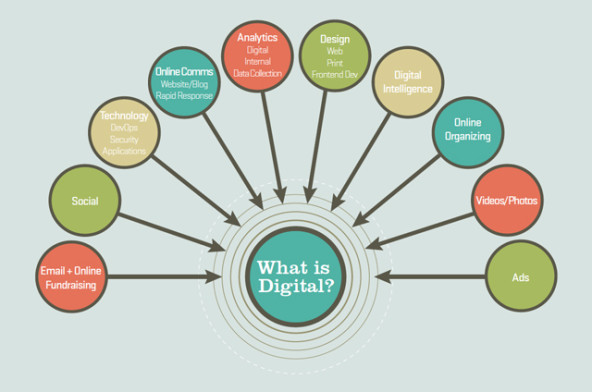The Presidential elections of 2008 and 2012 famously established new standards for how social and digital media could be used to identify supporters and motivate them to act. A cadre of young digital sophisticates borrowed ideas from the corporate world and from new forms of social interaction, and applied their own keen insights to reinvent the meaning of voter engagement and public participation in the political process.
The Joyce Foundation was interested in how digital media and technology were changing the work of the nonprofits we supported. As a non-partisan foundation dedicated to improving the quality of life in the Great Lakes region, we wanted to understand how the lessons from a watershed presidential campaign cycle could apply to the urgent public policy focus of our grantees. How could online advertising help organizations advocating for stronger policies to reduce the deadly toll of gun violence? How could email marketing further the work of groups dedicated to improving teacher quality in Illinois, Indiana, and Minnesota? And, what could be the role of social media in facilitating a public dialogue about protecting the water quality of our Great Lakes?
What we found was a tale of two cities. Many large nonprofits were adapting quickly, and thriving. But most small nonprofits had little or no digital presence, and were being left behind.
 (Image courtesy of Patrick Ruffini/Engage)
(Image courtesy of Patrick Ruffini/Engage)
We asked two of the nation’s top political digital strategists to translate their experience to the nonprofit world. Patrick Ruffini and Michael Slaby have worked for candidates on both sides of the aisle, and represent the best-in-class practitioners in digital media and technology. In the following essays, they share their recommendations for how nonprofits can advance social and policy change in a world that is being disrupted by digital change.
Are you enjoying this article? Read more like this, plus SSIR's full archive of content, when you subscribe.
Everyone knows that digital media and technology have transformed public engagement. According to an August 2012 Pew Internet and American Life survey, 81 percent of Americans use the Internet, with 69 percent of Americans using social media sites like Facebook or Twitter. Another October 2012 Pew study found that 66 percent of social media users—or 39 percent of American adults—have used social media to participate in civic, political, or policy engagement activities. Perhaps the most large-scale examples of this phenomenon are political campaigns. In the 2012 election, political campaigns used digital media and technology to raise hundreds of millions of dollars and attract tens of millions of activists, providing them with concrete ways to engage in the political process.
Nonprofits are, of course, very different from campaigns. For one thing, many of the groups we work with operate on much more meager budgets. According to the National Council of Nonprofits, over 80 percent of nonprofits have annual expenses of less than $1 million; in the heat of an electoral race, political campaigns can spend $1 million in a single day. And nonprofits don’t often have a prominent headliner to generate a fan following easily.
Still, there are strong parallels. In their daily work of public education and direct services, nonprofits must identify new sources of volunteers, engage their existing base of activists, and fundraise around mission-driven goals. So we wondered: How can these tools benefit the incredible work done by nonprofits every day?
After consulting an array of experts, we developed a better understanding of the problem: Our grantees lacked three basic things needed for using new media well—training, tools, and talent. In response, we made grants to help organizations develop these capacities. For example:
Training: Many of the nonprofits we support could benefit from a crash course in how to write a persuasive email or how to use Twitter effectively. Moreover, many are unaware of how to use online advertisements or how to establish relationships with bloggers. In partnership with the New Organizing Institute, the nation’s top training organization of online and offline organizers and community managers, we supported digital training opportunities for over 50 staff members from our grantee groups. The trainings included both basic and advanced courses about how to use a new generation of online tools to advance policy education goals.
Tools: We learned from national organizations like the Natural Resources Defense Council that online advertising was a major driver of the growth of organizational email lists and social media followers. So, we made grants to nonprofits to underwrite the costs of using Facebook or Google advertisements to persuade and acquire new supporters. For example, one of our grantees grew its email list by over 400 percent, with much of the growth originating from smart, targeted online advertising.
Talent: Last year, the Obama and Romney campaigns each employed over 100 staff members dedicated to digital campaigning. In larger organizations like the American Enterprise Institute or the Human Rights Campaign, there are entire departments and positions devoted solely to digital outreach and engagement. We set out to support these positions within the nonprofits we funded. For example, in one instance, we found a talented staff member internally and supported the development of her digital skills; in another instance, we funded a newly created “Digital Manager” position to oversee an online communications campaign.
The reality is that foundations have a major role to play in helping the nonprofit sector adapt to the digital revolution. We can take the long view and identify points of intersection across disciplines. We can invest in new ideas and withstand the failure inherent in iterating toward innovation. And, we have a useful role in convening the best experts available to identify challenges and propose solutions.
It is in this spirit that we introduce the following two essays. We hope their experience offers lessons to help you do your work better.
Download the PDF of this article.
Support SSIR’s coverage of cross-sector solutions to global challenges.
Help us further the reach of innovative ideas. Donate today.
Read more stories by Ellen S. Alberding.

